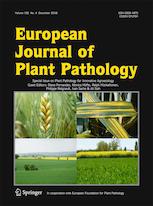Ver ítem
- xmlui.general.dspace_homeCentros e Institutos de InvestigaciónCIAP. Centro de Investigaciones AgropecuariasInstituto de Patología VegetalArtículos científicosxmlui.ArtifactBrowser.ItemViewer.trail
- Inicio
- Centros e Institutos de Investigación
- CIAP. Centro de Investigaciones Agropecuarias
- Instituto de Patología Vegetal
- Artículos científicos
- Ver ítem
Occurrence of the complete cycle of Puccinia sorghi Schw. in Argentina and implications on the common corn rust epidemiology
Resumen
The life-cycle of Puccinia sorghi, a heteroecious fungus, consists of five well-defined spore stages. The uredinial and telial stages are completed on the primary host (maize) whereas spermagonial and aecial stages occur on Oxalis spp., a perennial and widespread weed. Portions of corn leaves with telia were surface sterilized and placed in Petri dishes with 2% water agar and maintained in a growth chamber at 25 ± 1 °C and photoperiod of 16 h light and 8
[ver mas...]
The life-cycle of Puccinia sorghi, a heteroecious fungus, consists of five well-defined spore stages. The uredinial and telial stages are completed on the primary host (maize) whereas spermagonial and aecial stages occur on Oxalis spp., a perennial and widespread weed. Portions of corn leaves with telia were surface sterilized and placed in Petri dishes with 2% water agar and maintained in a growth chamber at 25 ± 1 °C and photoperiod of 16 h light and 8 h dark for 48 h to induce the formation of basidia and basidiospores. Oxalis conorrhiza plants were inoculated with those basidiospores, to confirm the generation of spermagonia with spermatia, and subsequently aecia with aeciospores. Corn plants were then inoculated with aeciospores to confirm the formation of urediospores and teliospores. The aecial phase of common corn rust was confirmed to occur on O. conhorriza and the descriptions of spore stages in Argentina are now reported in this work, confirming a potential sexual source of variability of P. sorghi. The natural occurrence of aecial infections on O. conhorriza in Córdoba may play an important role in generating new variants of P. sorghi in Argentina, allowing a constant adaptation of the pathogen to the environment of the different corn production zones.
[Cerrar]

Autor
Guerra, Fernando Andres;
de Rossi, Roberto Luis;
Brücher, Elsa;
Vuletic, Ezequiel Esteban;
Plazas, Maria Cristina;
Guerra, Gustavo Dario;
Ducasse, Daniel Adrian;
Fuente
European journal of plant pathology : 1–7. (2018)
Fecha
2018-12
Editorial
Springer
ISSN
0929-1873
1573-8469 (Online)
1573-8469 (Online)
Formato
pdf
Tipo de documento
artículo
Palabras Claves
Derechos de acceso
Restringido
 Excepto donde se diga explicitamente, este item se publica bajo la siguiente descripción: Creative Commons Attribution-NonCommercial-ShareAlike 2.5 Unported (CC BY-NC-SA 2.5)
Excepto donde se diga explicitamente, este item se publica bajo la siguiente descripción: Creative Commons Attribution-NonCommercial-ShareAlike 2.5 Unported (CC BY-NC-SA 2.5)

